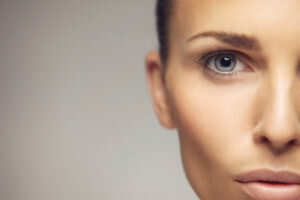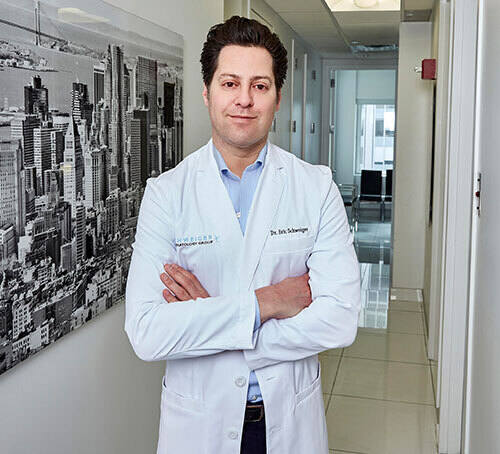Getting Even: How to Treat Age Spots and Red Spots on the Skin

Brown and red spots on the skin can be more than just annoying. When the skin shows any signs of discoloration, you can look much older than you are. Also, when you’re in the habit of using heavy makeup to cover up any pigmentation issues, you get into a vicious cycle. Plus, who wants to wear heavy makeup anyways? Here, Dr., discusses the best action plan for your skin when you want to rid of age spots.
Why do most of your patients come to you for spot removal?
In terms of brown spots, many people feel that these “age spots” or “sun spots” make them look older and prevent them from having an even complexion. Red spots are usually due to blood vessels in the skin and are more prominent in people who have rosacea.  Similar to brown spots, my patients like to get these red spots treated so they can have a more even complexion and can stop trying to hide them with makeup. I also see a lot of patients who have dark spots on the skin due to melasma and have tried various creams with little success.
What are your preferred in-office methods for evening out the skin tone and ridding of brown/red spots?
a: We have some wonderful light based technologies to help even out skin tone and treat brown and red spots. Photofacials, or IPL (Intense Pulsed Light), are used to treat brown and red spots, flushing of the skin, as well as to a lesser extent overall skin texture and pore size. Usually a series of 3-5 treatments spaced about a month apart are performed to achieve optimal results. With this treatment, patients can expect red spots in the skin to look slightly redder after the treatment for about two to five days, followed by disappearance. Brown spots will generally look darker for up to a week, after which they will crust off.
We also have specific lasers, such as the KTP and YAG lasers, to target overall redness in the skin, enlarged blood vessels, or redness that occurs in scars, such as after acne lesions have resolved. These lasers target the blood vessels and cause them to collapse, thereby reducing redness in the skin.
What is your best treatment option for acne scars?
For those patients who have scarring that is a bit deeper, as is the case with majority of acne patients, they need a treatment that will target those depressed scars. Fraxel laser skin resurfacing is the optimal treatment for these patients to effectively change the texture and appearance of their skin.  It’s also great for treating mild, moderate, or severe sun damage, softening lines and wrinkles, addressing stretch marks and scars, and treating abnormal pigmentation such as melasma and sun spots. This technology uses pinpoint laser beams creates microscopic channels within the skin, from which the skin will eliminate damaged skin cells and regenerate naturally with new, healthy skin.
The immediate results will be softer, brighter skin with a more even texture. The skin will continue to regenerate and improve over the next 3-6 months post treatment.  Depending on what is being treated, optimal results are obtained with a series of treatments, usually about a month apart. The Fraxel has two treatment modes: The Fraxel 1550 penetrates deeper and is effective at treating fine lines and wrinkles, scars, and large pores. The Fraxel 1927 targets discoloration, and is used to treat discoloration from acne, sun spots, and freckles.
How do you choose the correct treatment for each patient?
Picking the right treatment for a patient’s spots is dependent on understanding the location and type of pigment we need to target with our treatment, which is related to the source of the spot. For example, sun spots are typically caused by excess melanin, or pigment, at the junction of the first and second layers of the skin (the epidermis and dermis), and having this understanding will allow us to pick the correct device that will target the right pigment at the right level of the skin and effectively treat the spots. This is why it’s of utmost importance to go to a specialist who understands the skin as laser therapies are very targeted and its essential to recognize where in the skin the spot is located, not only for effective treatment but also for safety reasons.
What are your preferred at-home methods to treat spots? Any specific ingredients people should seek out?
In addition to getting treatments for brown spots in the office, there are a few things patients can do at home to treat these spots.
- Using a lightening agent prescribed by a dermatologist, usually hydroquinone based, regularly for the dark spots. The formation of pigment in the skin is a continuous process that necessitates daily treatment in most cases. There are also some great non-hydroquinone skin brightening lotions, such as Elure, which work well in conjunction with hydroquinone or alone.
- Equally as important is protecting from the sun and thereby preventing the appearance and worsening of brown spots.  Patients should use a broad-spectrum sunscreen with a SPF of at least 30 for everyday use, and higher if spending extending time outdoors.
Red spots and flushing unfortunately do not respond well to home treatments. Laser therapies are the most effective means by which to address these spots.
How do you feel about hydroquinone? It’s gotten a very bad rap and many people are afraid to use it.
Hydroquinone is safe and effective when used under the direction of a dermatologist.  There are risks involved, as with most medications, however, patients must be educated about these risks so that they can stop the medication at any sign of an adverse event.
